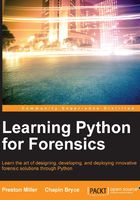
Preface
At the outset of writing Learning Python Forensics, we had one goal; teach the use of Python for forensics in such a way that readers with little to no programming experience could follow along immediately and develop practical code for use in casework. That's not to say that this book is intended for the Python neophyte; throughout we ease the reader into progressively more challenging code and end by incorporating each script into a forensic framework. This book makes a few assumptions about the reader's programming experience, and where it does, there will often be an Appendix section or a list of resources to help bridge the gap in knowledge.
The majority of the book will focus on developing code for various forensic artifacts; however, the first two chapters will teach the basics of the language. This will level the playing field for readers of all skill levels. We intend for the complete Python novice to be able to develop forensically sound and relevant scripts by the end of this book.
Much like in the real world, code development will follow a modular design. Initially, a script might be written one way before rewritten in another to show off the advantages (or disadvantages) of various techniques. Immersing you in this fashion will help build and strengthen the neural links required to retain the process of script design. To allow Python development to become second nature, please retype the exercises shown throughout the chapters for yourself to practice and learn common Python tropes. Never be afraid to modify the code, you will not break anything (except maybe your version of the script) and will have a better understanding of the inner workings of the code afterwards.